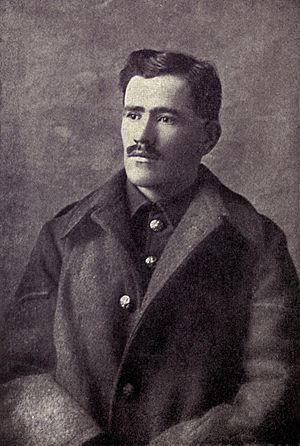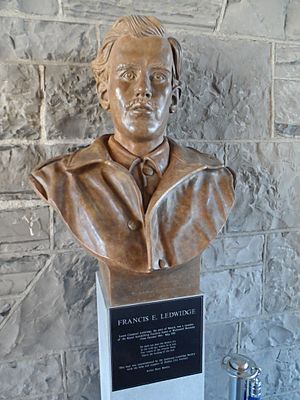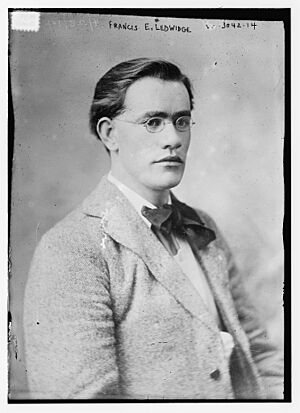Francis Ledwidge facts for kids
Quick facts for kids
Francis Ledwidge
|
|
|---|---|

Ledwidge in uniform
|
|
| Born | 19 August 1887 Janeville, Slane, County Meath |
| Died | 31 July 1917 (aged 29) Pilckem Ridge, near Boezinge, Passchendaele salient, Belgium |
| Occupation | Labourer, miner, writer and poet |
| Nationality | Irish |
| Period | 1890s–1917 |
| Genre | Poetry |
Francis Edward Ledwidge (born August 19, 1887 – died July 31, 1917) was a famous Irish poet from the early 1900s. He grew up in Slane, County Meath, Ireland. People sometimes called him the "poet of the blackbirds" because he wrote a lot about nature. Later, he became known as a "war poet" because he wrote poems while fighting in World War I.
Francis Ledwidge became friends with a well-known writer named Lord Dunsany. Lord Dunsany helped him get his poems published. Sadly, Francis Ledwidge was killed during the war in 1917 in a place called Ypres.
Francis came from a family that didn't have much money. He started writing poems when he was very young. His first poem was printed in a local newspaper when he was just 14 years old. He worked hard as a farmhand and a miner. He also cared a lot about workers' rights and his country.
Lord Dunsany gave Francis a special place to write in his castle library. There, Francis met other famous writers like William Butler Yeats. Lord Dunsany also helped publish Francis's first book of poems. Even though he was a poet, Francis also worked to help his community. He was elected to a local government job.
In 1914, Francis joined the army, even though some of his friends didn't want him to. He kept writing poems while he was a soldier. He would send his new poems to Lord Dunsany and his family. Francis Ledwidge was killed in July 1917 during a big battle called the Battle of Passchendaele. After he died, Lord Dunsany made sure more of his poems were published so everyone could read them.
Today, there is a museum in his childhood home in Slane. It opened in 1982 and tells the story of his life and work. Francis Ledwidge was also chosen as the only Irish poet for a special exhibit about war poets at the Imperial War Museum in London in 2002. Many events are held to remember him and his beautiful poetry.
Contents
Early Life and First Poems
Francis Ledwidge, who his family called "Frank," was born in a small village called Janeville, near Slane, in County Meath, Ireland. He was the eighth of nine children in a family that faced many challenges. His parents, Patrick and Anne Ledwidge, wanted their children to get the best education they could. But when Francis was only five, his father died. This meant Francis and his siblings had to start working at a young age to help the family.
Francis left school when he was thirteen. Even though he stopped formal schooling, he kept learning on his own. He took on many different jobs. He worked on farms, helped fix roads, and even worked in a copper mine near Slane. He was once fired from the mine because he helped organize a strike for better working conditions. This showed he cared deeply about fairness for workers. He even worked briefly in a shop in Dublin.
Francis was also involved with a group called the Meath Labour Union. He was known for his connections with Sinn Féin, a political party that wanted Ireland to be independent.
Becoming a Poet and Patriot
Francis Ledwidge was a strong person with striking brown eyes. He loved writing poetry and would write wherever he could, sometimes even on gates or fence posts! When he was 14, his poems started appearing in a local newspaper called the Drogheda Independent. His early poems often showed his love for the beautiful Boyne Valley area where he lived. His poems were also printed in other Irish newspapers, but he usually didn't get paid for them.
In 1912, while he was working on roads, Francis sent some of his early poems to Lord Dunsany. Lord Dunsany was a famous writer from Ireland. He saw that Francis's poems were special and had great potential. Lord Dunsany helped Francis meet other important Irish writers in Dublin, like William Butler Yeats.
Lord Dunsany supported Francis Ledwidge by giving him money and advice for several years. He also let Francis use the library at Dunsany Castle as a quiet place to write. There, Francis met another Irish writer, Katharine Tynan, and they wrote letters to each other often. Lord Dunsany later helped put together Francis's first book of poems, called Songs of the Fields. This book became very popular because it captured the beauty of rural Ireland.
Even though he became friends with the wealthy Lord Dunsany, Francis never forgot about working people. He helped start a branch of the Meath Labour Union in his hometown. He also studied the ideas of James Connolly, another Irish leader who believed in workers' rights. Francis felt that his Catholic faith and his belief in helping workers could go together. In 1914, he was elected to a local council, showing his commitment to his community.
Supporting Home Rule
Francis Ledwidge was a strong patriot and believed deeply in Irish nationalism. He tried to start a local group to promote the Irish language and culture, but it didn't work out. However, he did help start the Slane Branch of the Irish Volunteers in 1914 with his brother Joseph. This group was formed to make sure that Ireland would get "Home Rule," which meant Ireland would have its own government.
Joining the Army
When World War I began in August 1914, the Irish Volunteers split into two groups. One group supported joining the British army to help the Allies, and the other group did not. Francis first agreed with the group that did not want to join the war.
However, soon after, on October 24, 1914, he decided to join the army. He joined Lord Dunsany's regiment, the 5th battalion Royal Inniskilling Fusiliers. Lord Dunsany had even offered to pay Francis if he stayed out of the war. Some people thought Francis joined because his girlfriend had found someone new. But Francis himself wrote that he felt he had to fight to defend Ireland's freedom.
Writing Poems During War
Francis Ledwidge seemed to adapt well to army life and quickly became a lance corporal. In 1915, he fought in the Gallipoli Campaign, where he got very sick with rheumatism. He survived many difficult battles and became ill after a back injury during the Battle of Kosturino in Serbia in December 1915. This place inspired some of his poems.
He was promoted and then lost his stripes a few times. In January 1917, he was sent to the Western Front and became a lance corporal again.

Francis kept writing poems whenever he could during the war. He lost many of his writings because of bad weather in places like Serbia. He sent most of his poems to Lord Dunsany, who was also serving in the war, and to his family and friends.
His Death and What Happened Next
The poems Francis Ledwidge wrote during the war show how proud he was to be a soldier. He often wondered if he would die as a soldier. On July 31, 1917, Francis and his army group were building roads. This was to prepare for a big attack during the early part of the Third Battle of Ypres. They were near a village called Boezinge, close to Ypres in Belgium.
It was a very rainy afternoon. Even though it was raining, the German army kept firing shells. Francis and his comrades had to keep working on the roads because they were needed right away. They stopped for a moment to drink tea. Suddenly, a shell exploded right next to Francis, and he was killed instantly.
A Catholic priest, Father Devas, was the first to reach him. That night, Father Devas wrote in his diary that Francis had gone to confession and received Holy Communion just the day before.
Where He Was Buried
Francis Ledwidge was first buried in one place, but later his body was moved. He was re-buried in the Artillery Wood Commonwealth War Graves Commission Cemetery in Boezinge. Another famous poet, Hedd Wyn from Wales, who also died on the same day, is buried there too.
Stories About Him
There's a local story that says Francis Ledwidge's ghost appeared in Navan, Ireland, at the exact moment he died in Belgium. The story says his ghost greeted a friend before disappearing.
Remembering Francis Ledwidge
A stone tablet remembers Francis Ledwidge at the Island of Ireland Peace Park in Messines, Belgium. For many years, his poems were taught in Irish schools. Then, for a while, people didn't talk about his work as much. But now, there's new interest in his poems, and they are being read again.
Some of his poetry is also carved into the Flanders Fields memorial in Dublin's Peace Park.
Groups That Remember Him
A local group opened the Ledwidge Cottage Museum in his childhood home in Slane in June 1982. This museum shows items from his life and work. You can visit it for a small fee.
Another group, the Inchicore Ledwidge Society, was started in 1995 to remember him.
Events to Honor Him
In 1998, on the 81st anniversary of his death, a special monument was put up exactly where he was killed. It has a picture of Ledwidge and words from his poem "Soliloquy" in English and Dutch.
In 2002, Francis Ledwidge was chosen as one of only twelve World War I soldier poets to be featured in an exhibition at the Imperial War Museum. He was the only Irish poet chosen. His family and Lord Dunsany's castle lent original writings for the exhibit.
In 2017, there were many events to mark 100 years since his death. The main event was held at his birthplace cottage in Slane. There were also events in Ypres, Belgium, where he is buried, and in Dublin, where a music group called Anúna performed some of his poems set to music.
His Beliefs
Francis Ledwidge was known for his strong nationalist and left-wing beliefs. His poems like "O’Connell Street" and "Lament for the Poets of 1916" show that he felt a deep connection to the Irish Republicans who fought and died in the Easter Rising in 1916. He shared their dreams for an independent Ireland.
Images for kids




